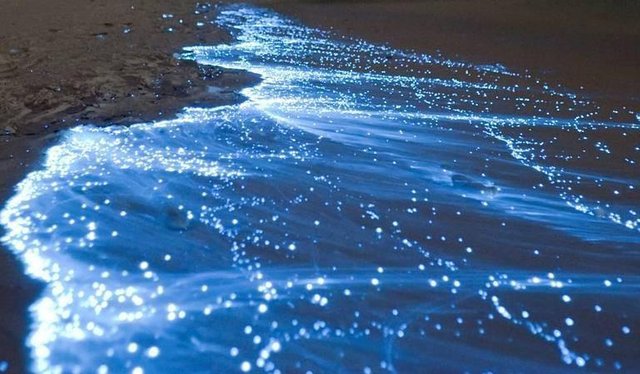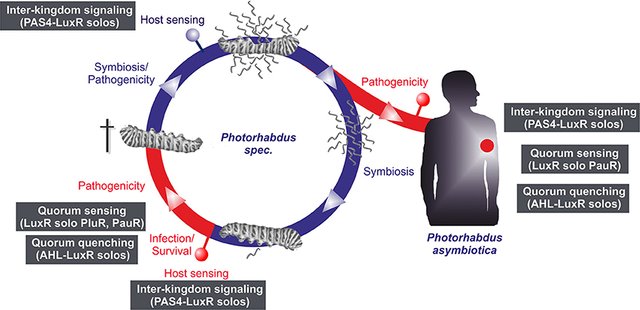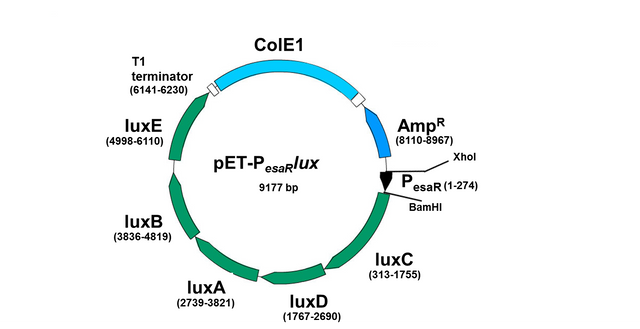Hey Steemians,
Today, in Microbial world I’ll be talking about the Bacterial Bioluminescence. You must have seen the glowing sea shores. So, what makes the water glow?

It’s the bacteria, which gives luminescence and make the water glowing. Vibrio fischeri a gram negative rods naturally inhabited in the sea water and basically live in a symbiotic relation with the marine animals.
The luminescence bacteria are widely distributed in light emitting organism, majority of them are seawater and some are also found in the terrestrial or fresh water environment. Some of these bacteria are free living while most of them live in symbiotic relation. There are several examples like fishes, squids, crabs, nematodes etc.

In symbiosis living, bacteria get nourished through the food available to the host and host utilizes the luminescence to attract the prey, communicate and save itself from the predators. There are certain species which are obligate symbionts and cannot be separated from their hosts. Three major genera Photobacterium, Vibrio and Photorhabdus are mainly known for the luminescence. Marine species are categorized into Vibrio and Photobacterium, while Photorhabdum species are found in terrestrial species.
Most of the luminescent bacteria are parasitic in nature, the Photorhabdus species are reported to infect terrestrial insects such as nematodes, caterpillars etc. However the free living bacteria that are dispersed in water are found in gut tract as well as on the body surface.

Bacteria residing in the gut tract of the marine animals produces extra cellular chitinase on the cell wall that facilitates the decomposition of the ingested chitin.
Biochemistry of the Bioluminescence
Bacterial luciferase is the responsible enzyme which catalyzes the light emission. The whole machinery involved in the light production in these bacteria are not only the enzyme luciferase, but also enzyme that supply and regenerate the luciferase substrate.

Luciferase enzyme is a heterodimer and composed of two different subunits alpha and beta encoded as luxA and luxB. In the absence of beta subunit alpha functions inefficiently with poor light yield.

Box represents the interaction between two subunits, involving ionic attractions, hydrogen bonds and hydrophobic interactions which helps the subunit to assemble and produce the functional bacterial luciferase.
So, what we can take from these bioluminescence bacteria. These luminescent enzymes producing genes can be used in various study like utilization as a Biosensor and Reporter for gene expression. We all know that bacteria can transfer their gene through plasmid, so the gene responsible for the luminescence can be transferred to the non-luminescent bacteria which further get converted into the luminescent bacteria.

Regulation of the luxCDABE expression in Luminous Bacteria- Quorum sensing.
Autocatalytic mechanism involved in regulation of luxCDABE expression.

The Bioluminescence was always been the major human attention. The luminescent organisms are reported to frighten the many of the individuals. However, the scientists are has the curiosity to solve this mystery. Isolation of the luminescent bacteria from their respective host organism and also the luminescent gene.
Reference and Suggested reading
Baldwin et. al., (1995) Structure of bacterial luciferase. Curr. Opin. Struct. Biol. 5: 798-809.
Bassler, B.L. (2002) Small talk. Cell-to-cell communication in bacteria. Proc. Natl. Acad. Sci. USA. 99: 3129-3134.
Chen et. al., (2002) Structural identification of a bacterial quorum-sensing signal containing boron. Nature 415: 545-549.
You may find these article of similar interest
The World of Un-culturable Bacteria

Microbial World #3 Predatory Bacteria: Class of new Antibiotics
Microbial World #4 Neurotoxins in your gut
Microbial World #5 Rise of Superbugs
Hope you have found this article inrteresting. If you do please upvote and resteem
I’ll be posting more of such wonders of nanoscience, follow my page for more of such articles.
Happy Reading :)
Vinamra
Hi! I am a robot. I just upvoted you! I found similar content that readers might be interested in:
http://photobiology.info/Lin.html
Downvoting a post can decrease pending rewards and make it less visible. Common reasons:
Submit
Just taken the reference format...........
Downvoting a post can decrease pending rewards and make it less visible. Common reasons:
Submit
Very interesting read. Nature, especially the depths of the ocean are so facinating. The seemingly endless possibilities of undiscovered life on our own planet alone is mindblowing in my opinion.
Downvoting a post can decrease pending rewards and make it less visible. Common reasons:
Submit
Thank you @fatmetal
yeah, almost 99% of the deep sea life is unknown.
Downvoting a post can decrease pending rewards and make it less visible. Common reasons:
Submit